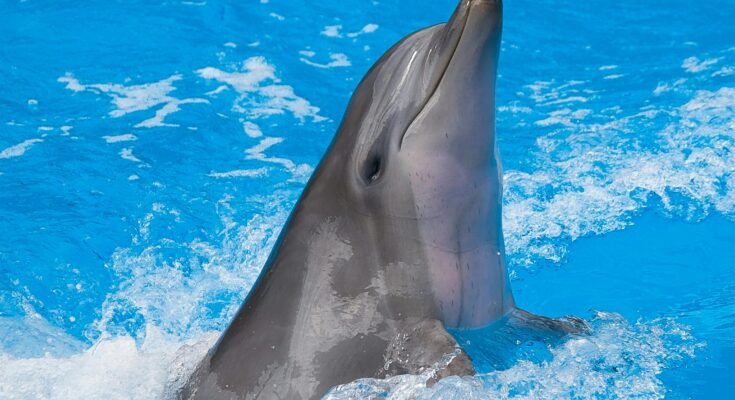Among the most intelligent, complex, and social animals on Earth, the dolphins together with their complicated societies and communications systems, have always fascinated researchers and animal lovers alike. One highly interesting aspect of dolphin behavior is their ability to teach and learn from each other, mainly teaching their offspring survival skills. This article will discuss some of the various ways through which dolphins pass on their knowledge to their young.
1.Social Learning of Dolphins: The Basis for Teaching
Dolphins form part of the family of cetaceans that include the whales and porpoises. Known for having great intelligence and adaptability, dolphins are performers of high intelligence and above all are social learners. Contrasted with those instinctive behaviors performed by many animals, social learning is the observation, imitation, and sometimes, when needed, the active teaching. All take place concerning the learning of specific skills and ways of survival.
The main means of teaching among dolphins is through direct observations and models. Young dolphins, or calves, watch their siblings and adults and model their behavior accordingly. This teaching is not solely limited to immediate survival skills but increasingly complex ones that assist the young dolphins in making sense of their role in the pod and interacting with many other dolphins. Their calves frequently observed both their mothers and other experienced adults in order to acquire crucial skills, as is shown by the researchers. These include hunting strategies that range from communication through whistle-sounding signatures.
2.Perhaps the best-case scenario of learning in the given species is the case of learning to hunt in dolphins.
Dolphins are highly adaptive predators, with each community coming up with their own ways to digest the prey. These hunting techniques are not instinctive; they are acquired.Calves closely follow their mothers or other adults as they learn how to forage successfully.
A case study of sponging-which is this applied behavior that mothers of bottlenose dolphins give in Shark Bay, Australia-is unique. In order to protect the dolphin’s snout from painful elbowing by sharp rocks, corals, and stinging animals, it uses marine sponges. This behavior had the beneficial effect on the injured dolphin and thus improved foraging efficiency in rocky environments. Sponging is passed almost exclusively matrilineally, and mothers teach their female offspring to sponge by example. This kind of culture is now acknowledged, and the dolphins show they can actually inherit a community-based “cultural” trait.
Mud-ring feeding is a hunting method observed only among a few dolphin communities. Bottlenose dolphins do this in the Florida Keys by circling a school of fish and creating a ring of mud. As the fish become enclosed and confused, it is on the cue for other dolphins in the group to swim through the ring and catch the fish. This technique requires cooperation and communication among the group; hence the younger ones need a lot of practice to learn it well.
3.Teaching Signature Whistles and Social Calls
Dolphins possess very complex vocalizations, which they will typically use for communicating with one another in pods. The communication of these dolphins becomes most interesting in the context of the signature whistles, as these whistles function similar to names in human society. Each dolphin has its own distinct signature whistle, and they are able to recognize signatures of other dolphins, even after years of separation.
Mothers teach them early on to whistle those whistles and respond to them as social bonding and recognition of their little ones. After that, the calves learn to imitate the whistles of mothers, which later develop into their signature whistles. This early communication indicates mother-calf bonding, which helps little ones to stay close to their mothers during the critical early phases of life.
Beyond signature whistles, dolphins learn social calls essential for group cohesion, particularly in hunting or predator evasion. In such cases of larger pods, dolphins will often coordinate calls among themselves, which help keep order and maintain group unity. These voice skills are critical for survival and are learned through active observation and interaction with experienced pod members.
4.Social Structures: Hierarchies, Alliances, and Play Behavior
Such social systems are highly elaborate and varied by dolphin species and locations. In bottlenosed dolphin populations, males are capable of forming stable, long-lived unions, thereby enhancing their efficiency in ranking orders during mate selection. Young males learn about these alliances from adults, developing an intuitive understanding of the workings of this social network.
Behaviors that the young calves engage in are played within the process of learning to interact and develop their roles in adult society. Such play behavior may include chasing, wrestling, or leaping and very much mimics that which is utilized in hunting and in establishing social interaction. Mothers and other adults encourage these types of play, enabling these young calves to build confidence and learn social skills. Play allows calves to understand competence hierarchy and establish limits for social behavior, which is critical for their social roles in pod life.
5.Problem-Solving and Tool Use: Higher Intelligence Level of Dolphins
Dolphins show, apart from multiple practical feeding techniques, a reasonable level of intelligence in solving problems, requiring the use of flexible thinking and adaptability. Amongst the dive recordings are those of dolphins evading predators, most commonly sharks, in a cooperative pattern by grouping around the team members at risk, calf-centered. Perhaps such behaviors are learned behaviors facilitated through mimicry and group experiences.
Innovative foraging techniques have likewise been observed in some populations of dolphins, thereby suggesting a level of creativity and inventiveness rarely witnessed in the wild. The use of sponge tools as a protective barrier in foraging captures one example of such ingenuity, as do behaviors where dolphins trailed fishing boats to scavenge away leftover fish or sought to blind prey via quick, sharp tail slaps.
Young dolphins master these problem-solving skills from watching adults and interacting in group activities. There are times when mothers or other adults lead calves into specific learning excursions or encourage the young of the pod to clothe themselves with newly learned pieces of behavior that the adults wish to pass on increase the calf’s chance of survival.
6.Migration and Navigation Skills-Homelands Passed On
Dolphins follow migrations for multiple long distances and journey in search of food and breeding-type conditions. In some species, the routes are homed in and span hundreds of miles. To travel along these routes, knowledge of ocean currents and seasonal variations and prey availability would be required. Older dolphins seem to instruct these routes to the younger members of the pod, showing the waters they will have to traverse all their lives.
In the lines of pods with strong maternal affections, the mothers guide their calves along established migration routes within their home ranges. They make the most extensive effort to enable the young dolphins to know the hunting grounds and safe resting spots. Such knowledge of home ranges nurtured through experience is very important for their survival since this allows them flexibility in tackling environmental changes like seasonal food shortages and threats posed by predators.
7.Threat Awareness-Teaching Young Dolphins about the School of Threats
Another threat to dolphins is dozens of natural predators, including sharks, and human action such as fishing, pollution, and boating. Most mature dolphins show great protectiveness over their young by teaching them of different possible dangers. In areas with high frequencies of shark attacks, dolphins might teach calves turning very quickly, diving down or swimming in tight formation.
Human interference, on the other hand, poses a very interesting challenge for dolphins, as mothers often teach calves to be careful around fishing gear and boats. Observations have shown dolphins avoiding areas where boats are very present, behaviour that is learned from calves or experiential learning. This for sure is something that dolphins have today become accustomed to and that which has definitely become survival equipment for really high traffic waters.
8.Conservation Implications: The Significance of Learning in Dolphins.
The immense capacity of dolphins to teach each other, and to learn new things, adds to their pool of survival skills, which in this day and age of changing oceans is very important. As more countries and societies develop, with lack of information causing a loss in dolphin habitat, and their control, it is important to investigate their cognitive abilities and ways of learning in order to help save these beautiful creatures. One common form of conservation entails awareness of the fact that different types of dolphins have’a particular set of culture specific behaviors that change with populations.’ Respects while puttingettain the learned traits such as g sponge throwing for example forches or mud – ringd feeding breast slugging activities can be effectively used within enclaves.
Continuing her work with these ocean allied beings, fraught with deep concern for their wellbeing, the marine biologist stalking brings to light in good time the place of learning across generations as an inherent trait of all animals. Generally, cultural inherited knowledge is expanded every generation, and calves benefitting from the knowledge of their mothers and pods are not only the key to dolphin survival but to the survival of boils of dolphins themselves. Thus, as some of the attempts to save their habitats, and limit other human interference, they also protect traditions, skills, and behaviors such as those described above, for the dolphins of the following generations.
When it comes to understanding the learning process in animals and their cultures, dolphins are one of the factors to observe. They possess many skills ranging from hunting to communication and display numerous teaching behaviors meant for the enhancement of survival and assimilation of the young dolphins. In their societies, one can see that learning is not rudimentary, and it has levels, just like the case of human beings, who learn from previous generations. To this end, it is important to realize what distinguishing factors cognizance has in dolphins and what their role plays in the necessity to conserve the natural environment in which they live for their survival and cultural existence.




James Jernigan’s channel is a must-watch for any marketer who wants to stay ahead of the game.